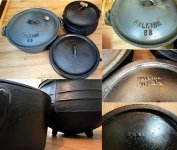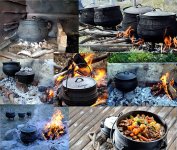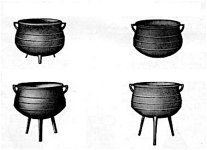Johan Maree
New member
I’d like to introduce you to Falkirk, a brand name unfamiliar to many of you, but treasured by people from Southern Africa as well as the United Kingdom.
Pictured below are two Dutch Ovens and a round belly, three-legged pot, or cauldron, if you like. The latter is quite legendary in Southern African cooking circles and is generally referred to as a “potjie pot” - pronounced as “poy-kee pot”.

So, what is a “potjie”? It literally means small pot and it came into prominence again during the ‘70’s when an outdoor cooking method called “potjiekos” (pot food) became highly popular. The idea is to cook all the ingredients in one pot over an open fire. It is essentially a stew and yet, it is not. If you search for “potjie” on YouTube a number of videos will pop up showing this cooking method.

According to information gleaned from the internet, cast iron existed as cookware in Europe since the iron age and “potjiekos” emerged in the Netherlands and Spain, when communities would cook together during wartime.
The three-legged pot is believed to have arrived in Africa in the 17th century with the early Dutch and British settlers. It was also adopted by the indigenous peoples, who replaced their clay pots with the iron potjie.
In Britain the pots were used on grills placed over the fire and so had flat bottoms. However, in many parts of the British Empire they were used directly on the fire. The three legged pots were designed for such use and were very popular in Africa.

The Falkirk Iron Company supplied thousands of pots to South Africa. Most of these had their names embossed on the side and so, in that part of the world, they became known as "Falkirk pots".
The first local manufacturer of the potjie pot was in the South African province of KwaZulu-Natal by the Durban Falkirk Iron Company, which was a joint venture between The Iron, Concrete and Asbestos Company (a South African foundry) and the Falkirk Iron Works (Scotland) set up just after World War I. Falkirk was the only South African supplier for nearly 70 years but is now defunct.
The three cast iron pots in the first image belonged to my father-in-law who has recently moved to an old-age home and I brought them all the way from South Africa about two weeks ago. I did not strip them down to bare metal at all. I cleaned the outsides a bit and they are ready for use. The inside surfaces have been taken good care of.
The large Dutch oven had a few rust spots on the outside (bottom) which I removed. It also has a colored lid, which is strange. It is also very heavy and comes in at 26 lbs 11 oz and measures 13½” across. The smaller one measures 10¾” across. The Potjie pot is unmarked and has a number on the lid that looks like 2CA. I assume it’s also a Falkirk and it measures 9” across and 7” deep and has stumpy legs.
These are heirlooms and I do not intend to sell them. I also have no idea how old they are but could be about 60 – 70 years old.
Pictured below are two Dutch Ovens and a round belly, three-legged pot, or cauldron, if you like. The latter is quite legendary in Southern African cooking circles and is generally referred to as a “potjie pot” - pronounced as “poy-kee pot”.

So, what is a “potjie”? It literally means small pot and it came into prominence again during the ‘70’s when an outdoor cooking method called “potjiekos” (pot food) became highly popular. The idea is to cook all the ingredients in one pot over an open fire. It is essentially a stew and yet, it is not. If you search for “potjie” on YouTube a number of videos will pop up showing this cooking method.

According to information gleaned from the internet, cast iron existed as cookware in Europe since the iron age and “potjiekos” emerged in the Netherlands and Spain, when communities would cook together during wartime.
The three-legged pot is believed to have arrived in Africa in the 17th century with the early Dutch and British settlers. It was also adopted by the indigenous peoples, who replaced their clay pots with the iron potjie.
In Britain the pots were used on grills placed over the fire and so had flat bottoms. However, in many parts of the British Empire they were used directly on the fire. The three legged pots were designed for such use and were very popular in Africa.

The Falkirk Iron Company supplied thousands of pots to South Africa. Most of these had their names embossed on the side and so, in that part of the world, they became known as "Falkirk pots".
The first local manufacturer of the potjie pot was in the South African province of KwaZulu-Natal by the Durban Falkirk Iron Company, which was a joint venture between The Iron, Concrete and Asbestos Company (a South African foundry) and the Falkirk Iron Works (Scotland) set up just after World War I. Falkirk was the only South African supplier for nearly 70 years but is now defunct.
The three cast iron pots in the first image belonged to my father-in-law who has recently moved to an old-age home and I brought them all the way from South Africa about two weeks ago. I did not strip them down to bare metal at all. I cleaned the outsides a bit and they are ready for use. The inside surfaces have been taken good care of.
The large Dutch oven had a few rust spots on the outside (bottom) which I removed. It also has a colored lid, which is strange. It is also very heavy and comes in at 26 lbs 11 oz and measures 13½” across. The smaller one measures 10¾” across. The Potjie pot is unmarked and has a number on the lid that looks like 2CA. I assume it’s also a Falkirk and it measures 9” across and 7” deep and has stumpy legs.
These are heirlooms and I do not intend to sell them. I also have no idea how old they are but could be about 60 – 70 years old.
